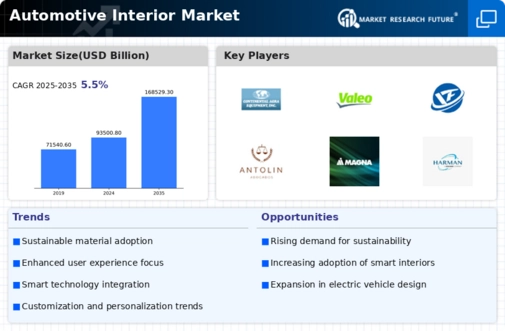Automotive Interior Market Summary
As per Market Research Future Analysis, the Automotive Interior Market was valued at 93500.76 USD Billion in 2024 and is projected to grow to 168532.55 USD Billion by 2035, with a CAGR of approximately 5.50% from 2025 to 2034. The market encompasses the design and manufacturing of vehicle interior components, including seats, dashboards, and infotainment systems. Key drivers include technological advancements, consumer demand for enhanced comfort and safety, and the adoption of innovative materials. The market is also witnessing a shift towards biodegradable and eco-friendly materials, reflecting a growing emphasis on sustainability in automotive design.
Key Market Trends & Highlights
The Automotive Interior Market is experiencing significant trends driven by consumer preferences and technological advancements.
- Market Size in 2024: 93500.76 USD Billion; Expected to reach 168532.55 USD Billion by 2035.
- CAGR from 2025 to 2034: Approximately 5.50%; driven by demand for advanced comfort and safety features.
- Asia-Pacific holds 42.8% market share; driven by strong automotive industries in China, Japan, and India.
- OEM segment dominated the market in 2022; reflecting the importance of original equipment manufacturers in vehicle production.
Market Size & Forecast
| 2024 Market Size | USD 93500.76 Billion |
| 2035 Market Size | USD 168532.55 Billion |
| CAGR (2025-2035) | 5.50% |
Major Players
Continental AG, Robert Bosch GmbH, Hyundai Mobis, Denso Corporation, Valeo, Panasonic Holdings Corporation, FORVIA Faurecia, ZF Friedrichshafen AG, Yanfeng, Antolin, Texas Instruments Incorporated, Magna International Inc, Harman International, Visteon Corporation, Nippon Seiki Co., Ltd.

















Leave a Comment